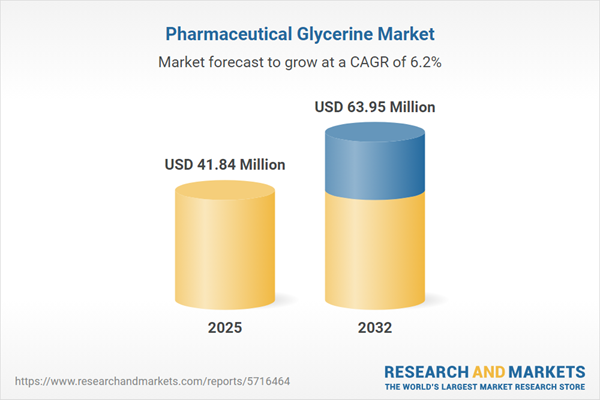Speak directly to the analyst to clarify any post sales queries you may have.
Leaders in the pharmaceutical glycerine market navigate a landscape defined by stringent compliance, supply chain intricacies, and rapid shifts in technology and regulation. This independent report gives senior decision-makers a strategic overview to inform agile and resilient operations in a highly regulated sector.
Market Snapshot: Pharmaceutical Glycerine Market Growth and Outlook
The pharmaceutical glycerine market is a foundational component of healthcare logistics, relied upon for the provision of high-purity excipients and sophisticated sourcing solutions. In 2024, the market reached a valuation of USD 39.40 million and is projected to rise to USD 41.84 million by 2025. Looking ahead, a compound annual growth rate of 6.23% is anticipated through 2032. These gains reflect a sector shaped by ongoing investment in advanced purification technologies, responsive regulatory frameworks, and logistical enhancements. Market participants prioritize process innovation and risk management, enabling robust partnerships and trust across the pharmaceutical supply chain.
Scope & Segmentation of the Pharmaceutical Glycerine Market
This report delivers actionable insights for strengthening supplier performance, enabling swift regulatory response, and boosting productivity within the pharmaceutical glycerine supply network. The report covers essential application areas, segmenting the market by end-use, technology, region, and source of inputs to ensure a holistic view.
- Applications: Analyzes pharmaceutical, biofuel, personal care, food and beverage, and industrial segments governed by strict quality and safety protocols.
- Biofuel: Highlights sustainability-driven uses including biodiesel and bioethanol, in line with industry carbon reduction targets.
- Food & Beverage: Addresses adaptation to global food safety standards and the influence of consumer demand for sourcing transparency.
- Industrial: Focuses on consistent outputs for chemical and cleaning sectors, with a strong emphasis on environmental and operational compliance.
- Personal Care: Details regulatory benchmarks impacting product formulation and safety in hygiene and skincare applications.
- Pharmaceuticals: Outlines the role of glycerine as a vital excipient supporting stability and efficacy in diverse medical formulations.
- Grades: Separates pharmaceutical, cosmetic, and industrial qualities, underscoring the need for robust quality controls and adaptable supplier relations.
- Product Types: Covers animal, synthetic, and vegetable-derived glycerine sources, supporting risk diversification and supply continuity strategies.
- Form: Assesses the operational advantages of liquid and powder formats, with a focus on flexible manufacturing and tailored production solutions.
- Purity: Examines the impact of high, medium, and standard purity levels on compliance and customization for end-use applications.
- Regions: Describes market drivers across the Americas, Europe, Middle East & Africa, and Asia-Pacific, spotlighting country-specific regulatory and market entry considerations in the U.S., Germany, China, India, and Brazil.
- Companies: Profiles major market players such as Cargill, Archer Daniels Midland Company, The Dow Chemical Company, Emery Oleochemicals, IOI Oleochemical Industries, Vantage Specialty Chemicals, Wilmar International, Croda International, BASF SE, and Godrej Industries, each contributing to market stability and compliance expertise.
Pharmaceutical Glycerine Market: Key Takeaways for Decision-Makers
- Building adaptability into the supply chain equips organizations to address regulatory fluctuations and maintain secure, steady operations.
- Continuous upgrades to purification and monitoring systems help sustain quality control while meeting evolving compliance mandates specific to this sector.
- Incorporating vegetable-based and renewable raw materials advances sustainability goals and mitigates emerging sourcing challenges.
- Advanced data analytics support process transparency, quicken R&D cycles, and foster a rapid response to evolving operational landscapes.
- Coordinating procurement and compliance functions with R&D enhances risk oversight and aligns readiness for new regulatory requirements.
- Diversification by product grade, region, and purity prepares leaders to address uncertainties proactively in both mature and developing markets.
Tariff Impact: Adapting to Trade Pressures and Supply Chain Change
With recent U.S. tariffs imposed on refined pharmaceutical glycerine, industry leaders are prioritizing domestic purification investments, fortifying supplier partnerships, and redesigning logistics for greater resilience. Enhanced compliance structures underpin operational continuity and competitive positioning as global trade dynamics evolve.
Methodology & Data Sources
This report’s findings are informed by direct interviews with senior procurement, compliance, and R&D leaders, cross-referenced with on-site assessments to ensure grounded analysis. Benchmarking and data triangulation provide further credibility to the strategic recommendations presented.
Why This Report Matters for Senior Leaders
- Enables rapid adaptation to regulatory shifts and supports proactive supply chain management when facing sector disruptions.
- Facilitates integration of advanced quality systems, contributing to a stronger organizational reputation and compliance within regulatory frameworks.
- Delivers actionable strategies for balancing operational risk and investment, protecting long-term business viability and flexibility.
Conclusion
Leaders in the pharmaceutical glycerine industry can apply insights from this report to drive compliance, operational agility, and informed strategic direction in a shifting marketplace.
Additional Product Information:
- Purchase of this report includes 1 year online access with quarterly updates.
- This report can be updated on request. Please contact our Customer Experience team using the Ask a Question widget on our website.
Table of Contents
3. Executive Summary
4. Market Overview
7. Cumulative Impact of Artificial Intelligence 2025
Companies Mentioned
The companies profiled in this Pharmaceutical Glycerine market report include:- Cargill, Incorporated
- Archer Daniels Midland Company
- The Dow Chemical Company
- Emery Oleochemicals (Germany) GmbH
- IOI Oleochemical Industries Sdn Bhd
- Vantage Specialty Chemicals LLC
- Wilmar International Limited
- Croda International PLC
- BASF SE
- Godrej Industries Limited
Table Information
| Report Attribute | Details |
|---|---|
| No. of Pages | 183 |
| Published | November 2025 |
| Forecast Period | 2025 - 2032 |
| Estimated Market Value ( USD | $ 41.84 Million |
| Forecasted Market Value ( USD | $ 63.95 Million |
| Compound Annual Growth Rate | 6.2% |
| Regions Covered | Global |
| No. of Companies Mentioned | 11 |









